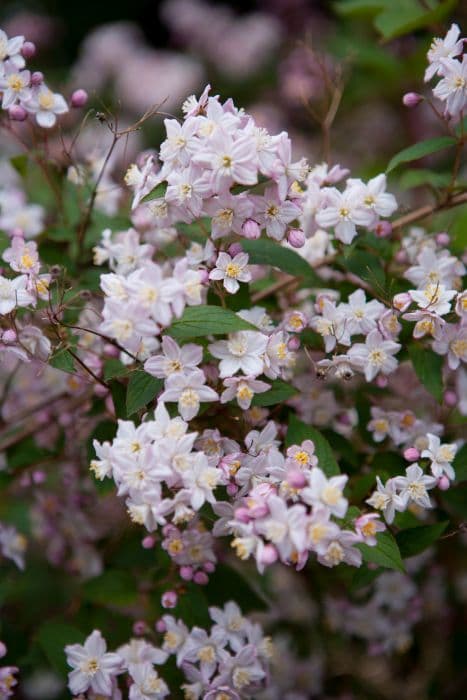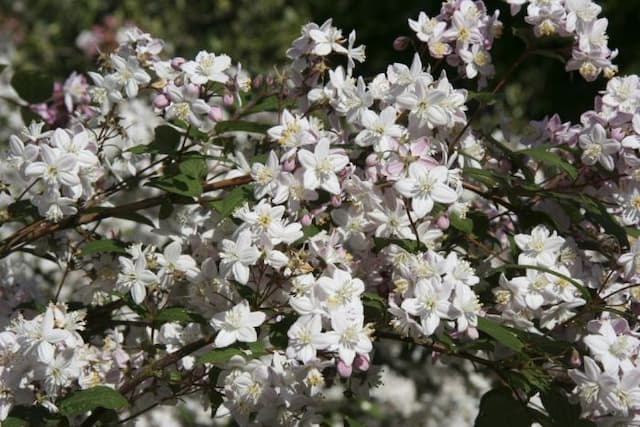Limelight Hydrangea Hydrangea paniculata 'Limelight' (PBR)

ABOUT
The Limelight hydrangea features distinctive lime-green flowers that bloom in large, rounded clusters, known as panicles. These blossoms typically transition from a bright, chartreuse green to softer shades of cream, pink, and dusty rose as the seasons progress from summer into fall. The flowers are held upright on sturdy stems and create a bold visual impact even from a distance. The foliage of the Limelight hydrangea is a deep green color, which provides a striking contrast to the bright flowers. The leaves are oval-shaped with pointed tips and have a leathery texture. Overall, the plant presents a lush and vibrant appearance, with its unique flower coloration among its most remarkable features.
About this plant
 Names
NamesFamily
Hydrangeaceae
Synonyms
Limelight Hydrangea, Panicle Hydrangea, Peegee Hydrangea
Common names
Hydrangea paniculata 'Limelight' (PBR)
 Toxicity
ToxicityTo humans
Limelight hydrangea is not known for being highly toxic to humans. However, like many members of the Hydrangea genus, it contains compounds that can potentially cause gastrointestinal upset if ingested. Symptoms of ingestion can include nausea, vomiting, and diarrhea. While serious toxicity is rare, it is advisable to keep this plant out of reach of children who might be tempted to eat its flowers or leaves. If ingestion occurs, seeking medical advice is recommended.
To pets
Limelight hydrangea is considered mildly toxic to pets, including cats and dogs. It contains compounds that can cause gastrointestinal irritation if consumed. Symptoms of hydrangea poisoning in pets might include vomiting, diarrhea, and depression. In more severe cases, ingestion could lead to more significant symptoms such as lethargy and confusion. Pet owners should prevent their animals from ingesting parts of the plant and should consult a veterinarian if they suspect their pet has eaten any part of a limelight hydrangea.
 Characteristics
CharacteristicsLife cycle
Perennials
Foliage type
Deciduous
Color of leaves
Green
Flower color
Cream
Height
6-8 feet (1.8-2.4 meters)
Spread
6-8 feet (1.8-2.4 meters)
Plant type
Shrub
Hardiness zones
3-8
Native area
China Japan Korea
Benefits
 General Benefits
General Benefits- Visual Interest: Limelight Hydrangeas provide a striking visual display with their large, light green to cream-colored flowers that turn to deep pink in the fall.
- Long Blooming Period: They have a long blooming season from mid-summer to fall, offering extended beauty in the garden.
- Drought Tolerance: Once established, Limelight Hydrangeas are somewhat drought tolerant, requiring less frequent watering.
- Ease of Care: They are relatively easy to care for and can thrive in a range of soil conditions if proper drainage is provided.
- Versatile Landscaping: These hydrangeas can be used as specimen plants, in mass plantings, or as hedges, proving to be versatile in landscape design.
- Attracts Pollinators: The flowers attract butterflies and other pollinators, enhancing the biodiversity of your garden.
- Winter Interest: They offer winter interest as well, as the faded flowers and structure of the plant can look attractive with frost or snow.
- Aesthetic Pruning: Limelight Hydrangeas are amenable to pruning, allowing gardeners to shape them according to their aesthetic preferences.
- Supports Local Wildlife: They provide food and habitation for local wildlife like birds and insects.
- Adaptable to Containers: Limelight Hydrangeas can be grown in containers, which is beneficial for those with limited garden space or who desire to adorn patios or decks.
 Medical Properties
Medical PropertiesThis plant is not used for medical purposes.
 Air-purifying Qualities
Air-purifying QualitiesThis plant is not specifically known for air purifying qualities.
 Other Uses
Other Uses- Pressed Flower Art: The distinct green to pink color of 'Limelight' hydrangea flowers can be preserved through pressing and used to create beautiful artwork and unique home decor accents.
- Dried Floral Arrangements: The robust blooms of this hydrangea dry exceptionally well, retaining much of their shape and color, making them ideal for dried floral bouquets that last indefinitely.
- Photography Prop: Due to its striking appearance when in full bloom, 'Limelight' hydrangea serves as a stunning subject or backdrop for garden photographers and plant enthusiasts.
- Wedding Decor: The soft yet vibrant hues of 'Limelight' hydrangea blooms are sought after for creating romantic and enchanting wedding centerpieces, bouquets, and venue decorations.
- Garden Focal Point: When planted en masse, 'Limelight' hydrangea can act as a dramatic focal point in landscape design, drawing the eye with its showy panicles.
- Holiday Wreaths: The blooms and foliage of 'Limelight' hydrangea can be incorporated into holiday wreaths, offering an unconventional twist to traditional evergreen wreaths.
- Educational Tool: 'Limelight' hydrangea can be used in educational settings, like botany classes, to illustrate plant care, pruning techniques, and the science of flower color change.
- Culinary Garnish: While not edible, the flowers may be used as a temporary organic garnish for plating in upscale culinary presentations, as long as they're removed before consumption.
- Ice Embedments: Individual flowers or small clusters can be frozen into ice cubes or blocks to create an elegant and decorative touch for punch bowls or other cold beverages at special events.
- Art Inspiration: The unique color and form of 'Limelight' hydrangea inspire artists to capture its beauty through various mediums such as watercolor, oil painting, and digital art.
Interesting Facts
 Feng Shui
Feng ShuiThe Limelight Hydrangea is not used in Feng Shui practice.
 Zodiac Sign Compitability
Zodiac Sign CompitabilityThe Limelight Hydrangea is not used in astrology practice.
 Plant Symbolism
Plant Symbolism- Heartfelt Emotions: Hydrangeas, including the 'Limelight', symbolize deep-rooted and sincere emotions owing to their lush and abundant flower heads.
- Gratitude: 'Limelight' hydrangeas are often given as gifts to express thanks and appreciation, with their showy blooms embodying the giver's gratefulness.
- Understanding: The fullness of the blooms can represent comprehension and enlightenment, suggesting a level of depth in the giver's sentiments.
- Vanity: In some contexts, hydrangeas may symbolize vanity or boastfulness, as their lavish appearance could reflect self-admiration.
- Abundance: The overflowing nature of 'Limelight' hydrangea's flowers is often tied to abundance, reflecting prosperity and bounty.
- Beauty: This variety, with its striking pale-lime blooms, is frequently associated with beauty and grace.
- Fourth Wedding Anniversary: Hydrangeas are traditionally linked to the fourth wedding anniversary, representing appreciation and lasting gratitude between spouses.
 Water
WaterThe Limelight Hydrangea should be watered deeply once a week, providing about 1 gallon of water for each plant during the growing season. During periods of drought or extreme heat, increase watering frequency to twice a week, ensuring the soil is moist but not overly saturated. In the fall, you can reduce watering as the plant prepares for dormancy. It's important to avoid overhead watering to prevent leaf diseases and focus on watering at the base of the plant.
 Light
LightThe Limelight Hydrangea thrives in partial to full sunlight, requiring at least 4 hours of direct sunlight each day. An optimal spot would be one where the plant receives morning sunlight and afternoon shade, which helps protect it from the intense heat of late-day sun.
 Temperature
TemperatureThe Limelight Hydrangea prefers temperatures between 60 and 80 degrees Fahrenheit but can tolerate temperatures as low as 30 degrees Fahrenheit without significant damage. It's important to protect the plant from temperatures below this range to prevent frost damage.
 Pruning
PruningThe Limelight Hydrangea benefits from pruning to encourage robust growth and maintain a neat shape. Prune in late winter or early spring before new growth begins, cutting back about one-third of the oldest stems to the ground. This helps to invigorate the plant and promotes larger blooms.
 Cleaning
CleaningAs needed
 Soil
SoilFor Limelight Hydrangea, the best soil mix is one that is rich, moist, and well-draining, with organic matter such as compost integrated into it. The soil pH should be maintained around 6.0 to 7.0, as this cultivar's flower color is not affected by soil pH.
 Repotting
RepottingLimelight Hydrangeas are typically grown in the ground and do not require frequent repotting. If grown in containers, they should be repotted when they outgrow their current pot, which may be every 2-3 years.
 Humidity & Misting
Humidity & MistingLimelight Hydrangeas prefer average humidity levels. They thrive outdoors where the natural environment will usually provide the necessary humidity without special attention.
 Suitable locations
Suitable locationsIndoor
Provide bright light and room to grow.
Outdoor
Ensure full sun to partial shade, mulch, and space well.
Hardiness zone
3-8 USDA.
 Life cycle
Life cycleThe 'Limelight' Hydrangea (Hydrangea paniculata 'Limelight') begins its life cycle when the dormant buds break in early spring, proceeding into the growth stage where new stems and foliage emerge. Throughout the spring and early summer, the plant focuses energy on vegetative growth, developing a strong woody framework and lush green leaves. By mid to late summer, it transitions to the flowering stage, producing large, showy panicles of lime-green flowers that gradually turn to shades of pink, red, and burgundy as they age. After the blooming period, in the fall, the flowers may be left on the plant to add winter interest and also provide protection for the developing buds of the next cycle. During winter, the 'Limelight' Hydrangea enters a period of dormancy, where metabolic activity slows, conserving energy to survive the cold. In the next growing season, the cycle restarts as the plant resumes growth from the overwintered buds.
 Propogation
PropogationPropogation time
Early Spring
The most popular method of propagation for Hydrangea paniculata 'Limelight', often referred to simply as 'Limelight' hydrangea, is through softwood cuttings. This technique is typically performed in late spring or early summer when the new growth is still tender but has begun to mature and harden slightly. Gardeners should select healthy, non-flowering shoots and cut a 4 to 6-inch (approximately 10 to 15 cm) section, making sure there are several leaves present. The lower leaves are removed, and the cut end is dipped in rooting hormone to encourage root development. The prepared cutting is then placed in a well-draining potting mix, ensuring the remaining leaves are above the soil surface. The pot should be kept in a warm, humid environment with indirect light until roots have formed, which usually takes several weeks. Once the roots are established, the new hydrangea plants can be transferred to a more permanent location in the garden.








![Hydrangea [Early Sensation]](/_next/image?url=https%3A%2F%2Fplants-admin.emdemapps.com%2Fimages%2Fplants%2F%2Fimages%2F604b6150338db.png&w=640&q=75)
